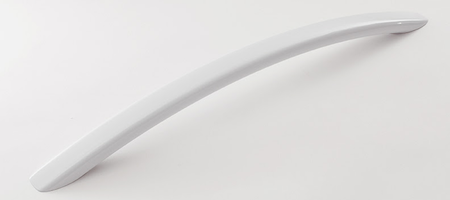Today, tubular hydroforming is not only an accepted way to produce metal appliance handles, it is often the preferred method. There are several reasons this simply make sense.
For one, there are the production considerations: Hydroforming uses less material, produces parts that are lighter weight, and still maintains the stiffness and strength yielded by other, more traditional ways of manufacturing appliance handles.
Then, there is the cost issue: Hydroforming leads to lower costs in many situations.
And lastly, aesthetics: Hydrofoming produces a more attractive finished product and, to boot, allows design engineers to better “stretch their wings” when it comes to designing appliance handles.
Together, these benefits can provide appliance manufacturers a terrific competitive advantage, especially limited-edition or higher-end brands since tooling costs for hydroformed handles are often significantly lower than for traditional stamping, for example, meaning that hydroforming can economically support shorter runs of appliance handles (e.g., in the tens of thousands).
In this article, we’ll delve into the virtues of hydroforming for appliance handle manufacturing more specifically, starting with a discussion of the general manufacturing process.
What Is Tubular Hydroforming?
Tubular hydroforming is a metal fabrication process that has been around since the 1950s. In essence, anything that can be made from a metal tube work piece can be shaped through the tubular hydroforming process, including appliance handles.
Tubular hydroforming uses pressurized liquid to form metal into desired shapes. The process includes forcing hydraulic fluid into a metal tube in a mold at an extremely high pressure. This forces the metal material into all nooks and crannies of the mold. It does this while keeping the metal evenly spread out.
Hydroforming can be used to “replace” stamping and eliminate welding steps. Rather than having the metal stamped, pressed, or shaped over a metal die or form, which can weaken its strength, the stronger tubular form actually creates additional strength that can be made even stronger through heat treating.
Hydroforming also allows for the production of more complex shapes and designs while maintaining strength. It can be used to form steel, aluminum, stainless steel, copper, and more, opening up possibilities for a wide variety of aesthetics. Hydroforming also produces a more finished appearance.
These are just some of the general benefits of tubular hydroforming. Below we dig into more specifics when it comes to our area of specialty — thin-wall tubular hydroforming.
The Benefits of Thin-Wall Tubular Hydroforming
At Mills Products, we specialize in thin-wall tubular hydroforming that allows us to produce lightweight, complex parts with seamless aesthetics that would be impossible to reproduce cost-effectively using traditional forming methods. The benefits of hydroforming appliance handles include:
- Reduced Weight
Because hydroforming doesn’t use as many welds, walls can be thinner while maintaining strength. Most hydroformed parts are produced at reduced weights compared to other metal processes. - Excellent Bending Strength & Stiffness
Perhaps the greatest advantage of tubular hydroforming is the exceptional bending strength and stiffness achieved through the process. This is critical in the manufacturing of appliance handles that may be in service for decades. - Accommodates Creative Designs
Hydroforming allows design engineers in the appliance industry greater freedom and creativity. This is particularly important in the specialty and upscale appliance markets where unique design elements are valued. - Lower Costs
Tubular hydroforming allows for lower per-unit costs on smaller runs and is an excellent process for producing prototypes. Hydroforming also eliminates machining, which reduces handling, thereby further minimizing production costs. - Improved Appearance
Because hydroforming utilizes high-pressure liquid to form metal parts as opposed to a physical stamping and welding process, surfaces are left with a superior finish, giving hydroformed parts generally higher-quality appearances for less cost. Once formed and washed, parts can be taken to a laser center where they can be further finished through trimming, cutting, and even for etching.
Mills Products’s Role as a Supplier of Appliance Handles
Mills Products was the first company to introduce stainless steel tubular hydroforming to the appliance industry back in 2001. Today, we are recognized globally for our ability to convert multi-part assemblies into lighter and stronger metal hydroformed parts. We continue to be held in high regard for our efficient production of quality appliance handles, even those with unique design elements.
If you are in search of a quality supplier of hydroformed appliance handles or other fabricated metal parts, contact us today. We’ll further explain our manufacturing options, the benefits of nearshoring here in the United States, and demonstrate the quality and value of our hydroformed metal parts.
You can also get answers to your design questions from the pioneers in stainless steel hydroforming by downloading our free publication, the “Definitive Tubular Hydroforming Guide.”


